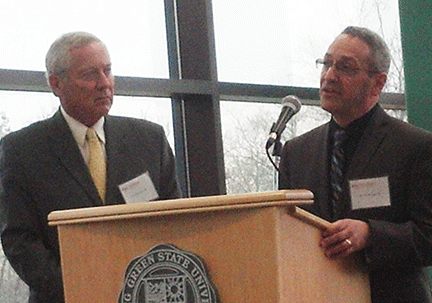by Alan Marrs
Be there, build your resume and be open to opportunities. Simple, but important concepts expressed by Frank Supovitz, senior vice president of events for the National Football League, talking to students of sport management and media April 24.
These ideas were continued on the next morning by representatives from the Pro Football Hall of Fame to classes of media and communications.
“No matter what, all your time spent here is valuable, so take advantage of every opportunity you have and use it to sell yourself,” Jason Rentner, web production specialist for the Pro Football Hall of Fame and 2009 graduate of Bowling Green State University, said.
Supovitz and Rentner, along with Manager of Digital Media and Communications Peter Fierle and Educational Programs Coordinator Jerry Csaki of the Pro Football Hall of Fame, were brought to BGSU by the Richard A. Maxwell Sport Media Project.

Alumnus Dick Maxwell with Frank Supovitz, senior vice president of events for the NFL, at the reception prior to the evening speaking event.
Supovitz, speaking at the third “A Conversation With…” event, talked about his journey to the NFL coming from Queens College in New York City as a biology major.
He worked as an usher at Radio City Music Hall while he was a student, eventually joining full-time as a member of the management team. He moved into marketing for Radio City, handling events being outsourced to the venue, approximately 50 percent of those being sports.
Supovitz joined the National Hockey League in 1991 as the director of events and moved to the NFL in 2005.
“I have to tell you what incredible opportunities you have before you,” Supovitz said. “Programs like this didn’t exist when I went to college in the Jurassic era. If they had existed, I wouldn’t have this job.”
Supovitz also spoke of his experiences in the NFL handling events such as the Super Bowl, the NFL Draft and the Pro Football Hall of Fame Enshrinement.
“The thing that is the toughest year in and year out, it would be trying to better what you did before,” Supovitz said. “You want to continue to innovate. You want to continue to bring new life and new interest and new intrigue to everything you do.”
He also expressed the uniqueness of the massive events organized by the NFL that focus on a game of football.
“It’s a massive undertaking for one game,” Supovitz said. “It’s kind of like building Disneyland for one day and operating it for one day. Then taking it down after the only day it operates and you move it 2,000 miles, and then you build it over there.”
It takes 20,000 employees that have to be trained and managed for the events, but Supovitz claims “the best members at a Super Bowl are from Bowling Green State University.”
He was met with a round of applause after those comments by the students.
The sports industry is favorable for employment, and Supovitz does not see that changing.
“You’re not going to be replaced by an ATM,” Supovitz said. “It’s live. It’s human. It’s compelling and you can’t be obsolete, because a machine can’t take your place to do those things. And I think that’s a strength of this industry.”
The conversation with Supovitz was held in front of a full audience of students and faculty from the schools of sport management and media and communications.

Jerry Csaki, educational director for Hall of Fame, and Jason Rentner, alumnus and web production specialist at the Hall of Fame
On Friday morning, Fierle, Csaki and Rentner spoke in front of two journalism classes as a part of an entire day speaking to various classes.
They spoke of what the Pro Football Hall of Fame does for the sport.
“We tell the story of the game,” Fierle said.
Their story of the game has changed recently, with naming David Baker as president and executive director of the Hall of Fame on Jan. 6.
Baker put forth a new mission statement for the Hall of Fame. Honor the heroes of the game, preserve the history, promote its value and celebrate excellence everywhere.
This is characterized by the class of 2014 by Fierle as the “class of character.”
The roles of Fierle, Csaki and Rentner are all different, but focus on the mission statement of the Hall of Fame to increase the message globally beyond the walls of the museum in Canton, Ohio.
All three of them expressed evolution to their respective careers.
Fierle, as manager of digital media and communications, was with the Hall of Fame when digital communications did not exist, but adapting to them has made an exciting future.
Csaki came to the Hall of Fame as a graduate of sport business from the University of Mount Union where the educational program was field trips for students to Canton. He has grown the educational program to reach 15,000 to 20,000 students daily through video conferencing and multiple educational programs.
“If we stop growing at our job, we should leave,” Fierle said.
Rentner joined the Hall of Fame as a web content programmer. He attributed his experiences working with the athletic department, BG News and the Public Relations Student Society of America while at BGSU that aided his ability to transition to the position he has at the Hall of Fame.
“Pete [Fierle] inspired me to really go after my dreams and really be a go-getter in the job market,” Janel Hlebak, a journalism student, said. “Personally, sports aren’t my thing of interest, but I thought that was helpful.”
BGSU students have an opportunity at an exclusive internship with the Pro Football Hall of Fame through a partnership with the Maxwell Project.
